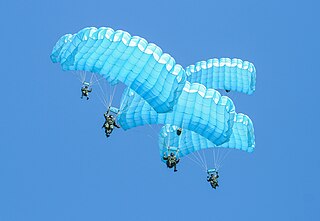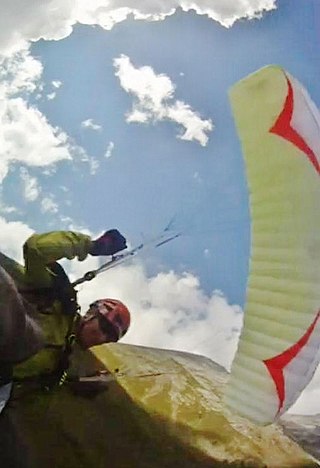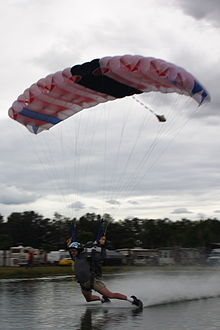
A parachute is a device used to slow the motion of an object through an atmosphere by creating drag or, in a ram-air parachute, aerodynamic lift. A major application is to support people, for recreation or as a safety device for aviators, who can exit from an aircraft at height and descend safely to earth.

Free flying is a skydiving discipline that began in the late 1980s, involving falling free in various vertical orientations, as opposed to the traditional "belly-to-earth" orientation. The discipline is known to have originated when Olav Zipser began experimenting with non-traditional forms of Body flight. Zipser founded the Free Fly Clowns as a two-person competitive team with Mike Vail in 1992. He was joined by Omar Alhegelan, Charles Bryan, and Stefania Martinengo in 1994. The Free Fly Clowns are also credited with opening the first school to teach free flying, The First School of Modern Skydiving.

Paragliding is the recreational and competitive adventure sport of flying paragliders: lightweight, free-flying, foot-launched glider aircraft with no rigid primary structure. The pilot sits in a harness or in a cocoon-like 'pod' suspended below a fabric wing. Wing shape is maintained by the suspension lines, the pressure of air entering vents in the front of the wing, and the aerodynamic forces of the air flowing over the outside.

Sky surfing is a type of skydiving and extreme sport in which the skydiver wears a custom skysurf board attached to the feet and performs surfing-style aerobatics during freefall.

Wingsuit flying is the sport of skydiving using a webbing-sleeved jumpsuit called a wingsuit to add webbed area to the diver's body and generate increased lift, which allows extended air time by gliding flight rather than just free falling. The modern wingsuit, first developed in the late 1990s, uses a pair of fabric membranes stretched flat between the arms and flanks/thighs to imitate an airfoil, and often also between the legs to function as a tail and allow some aerial steering.

A malfunction is a partial or total failure of a parachuting device to operate as intended. Malfunctions may require a skydiver to cut away their main parachute and deploy the reserve parachute.
Freestyle skydiving is a competitive skydiving discipline where one member of a two-person team performs acrobatic manoeuvres in free fall while the other one films the performance from a close distance using a helmet-mounted camera.

The United States Army Parachute Team, nicknamed the Golden Knights, is a demonstration and competition parachute team of the United States Army. It consists of demonstration and competition parachutist teams, drawn from all branches of the U.S. Army. Members must demonstrate excellence in parachuting.

Roger Warren Nelson was a skydiver, convicted drug smuggler, and founder of Skydive Chicago, one of the largest skydiving centers in the United States.

Skydive Hibaldstow is a parachuting and skydiving drop zone centre in Hibaldstow, North Lincolnshire, England. Skydive Hibaldstow is affiliated with the skydiving company British Skydiving.
James Paul Slaton is a professional skydiver and founder of the Pro Swooping Tour, the Canopy Piloting Circuit, and the Ground Launch Center.
Cheryl Stearns is an American skydiver.

Parachuting and skydiving are methods of descending from a high point in an atmosphere to the ground or ocean surface with the aid of gravity, involving the control of speed during the descent using a parachute or multiple parachutes.
The Pro Swooping Tour (PST) is a professional competition circuit for an extreme form of parachuting called "canopy piloting". The PST was formed in 2003 by producer Jim P. Slaton and his associate Lyle Presse. Slaton & Lyle presented the sport's competition format and rules to the International Parachute Committee (IPC) at the 54th annual meeting in Brazil in 2003. The PST's efforts paid off and the IPC accepted the new sport of "Canopy Piloting". The PST created the competition format which gave birth to modern day canopy piloting.
Speed skydiving is a skydiving competition in which the goal is to achieve and maintain the highest possible terminal velocity. It was developed in the late 1990s and is the fastest non-motorized sport on Earth. The speed, achieved by the human body in free fall, is a function of several factors; including the body's mass, orientation, and skin area and texture. In stable, belly-to-earth position, terminal velocity is about 200 km/h (120 mph). Stable freefall head down position has a terminal speed of 240–290 km/h. Further minimization of drag by streamlining the body allows for speeds over 500 km/h (310 mph).

Speed-flying and speed-riding are advanced disciplines close to paragliding that use a small, high-performance non-rigid wing to quickly descend heights such as mountains. Speed flying and speed riding are very similar sports; speed flying is when the speed wing is foot-launched, while speed riding is a winter sport done on skis.

Luigi Cani is a Brazilian stunt performer and cinematographic producer. He is a well known athlete in parachuting.
World Parachuting Championships is the main competitive parachuting championships in the World, and is organised by Fédération Aéronautique Internationale.

Skydive Empuriabrava is the brand that has been commercially operating Empuriabrava Aerodrome since 1985. Since it began operating, its main activity has been skydiving although it also offers photo flights, aerial and tourist advertising, and runs a school of aviation for private pilots.
Daedalus Project is a brand of competition skydiving parachutes designed and manufactured by New Zealand manufacturer NZ Aerosports Ltd, for the sport of canopy piloting.













